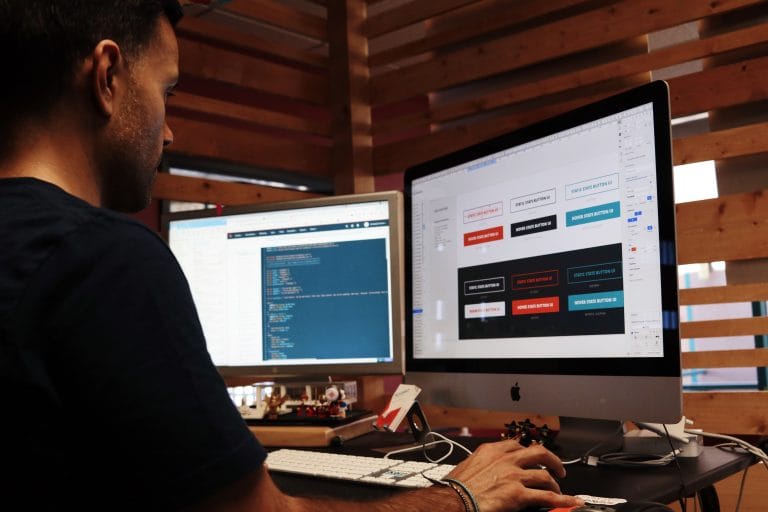
- Contact Sales:
- (310) 826-6800

It has been a great discussion for companies on which is better, to hire Managed IT services or In-house IT Support?
Before providing you with answers, did you know that companies that avail outsourcing service get an ROI of over 25%?
With this percentage, it is obvious that the better option is Managed IT Services. However, ZZ Computer gives you the pros and cons of working with Managed IT Services and In-House IT Support, so that you can get a birdseye view of what it’s like to work with both.
One thing that makes IT managed services better than in-house IT is the ability of the former to provide 24/7 support. The majority of the IT companies offer this 24/7 support because they have teams that can work on calls. So, this means that managed IT services can fix any issue even after hours whether it’s late or not. System failures are common and cause disruptions to your business’ operation, so being able to solve or fix those problems can immediately ensure you that anytime it can be fixed preventing you from downtime.
A common scenario of IT service is that it only provides IT-related services when there’s something to fix or break. But the great thing about a managed IT company is that it gives you proactive maintenance and management such as system monitoring, adopting the latest apps and technologies for business advancement, and many more.
Through proactive maintenance and management, you prevent future disruptions from happening. Also, it gives a better user experience for your team and clients that help you continue your business ops without a fuss.
According to a study, there is about 74% of companies outsource IT and the reason is that you can hand over entire business functions to instantly expand your company’s skillset such as high-tech services. This means that by availing of their services, you’ll be able to get new technologies and apps that bring the best out of your business. No need for you to learn how to download or avail of those trendy techs, you just have to pay a plan and then, you can have those techs and apps that every company wants.
The best advantage of managed IT service or support in Los Angeles is that it is cost-effective over in-house IT.
Why?
Based on the latest study, companies can save up to 55% IT costs when choosing to avail or outsource IT. And the reason is that managed IT service or support companies offer you a fixed price per month or year. Also, with their wide range of connections, they can give you affordable hardware and software products for your business.
And although managed IT services and support can give you the best advantages for your business, there are still things that you should be aware of. And these are the following disadvantages:
The lack of knowledge of the inside and out of your company might confuse both of you when there’s no proper communication.
But this can be avoided through proper communication through meetings and orientation. And while this can be a disadvantage, this disadvantage can also be a good thing because you can assure that they won’t have any personal agendas to your company.
The most common reason why clients avoid getting IT services from an outside provider is that the fear of being “hacked”. But if you just hire reliable IT support providers, you won’t have a problem getting one. Just make sure you hire a managed it support that has been in the business for quite some time.
The advantage of in-house IT is that you can choose the person you want to work with. If you’re meticulous in picking the right person then this is really an advantage. But it’s not a guarantee that such a person performs best.
But, it is noteworthy to remember that with Managed It Services you can still choose the people you want to work with or request someone you like with a certain project. As a matter of fact, you can talk with them to get to know them better.
Another advantage is that you have full control over your IT goals and functions. This means that you can choose the software and type of programs you want. But the downfall is, you’ll also suffer the consequences in case it fails.
Not only is overtime pays are of burden but also working with in-house IT is also more expensive. You pay for their training, government-mandate benefits, hiring & onboarding cost, and payroll expenses.
Another great problem is that the more your company grows, the greater the need to hire another IT specialist to work with your current IT staff.
One of the obvious disadvantages of in-house IT is that you might pay for overtime pays and no 24/7 support. Reality speaking, IT staff can only work with you during working hours. Working outside the typical hours is an additional expense.
This means that if something goes wrong during late hours, you are obliged to give them overtime pay.
Another disadvantage of working with in-house IT support is that you will have minimal access to resources such as technologies, discounts, and knowledge. There’s a saying that more is better. And it’s true because when you’re working with Manage IT services, you’re working with a team. Unlike the in-house IT support, you’re only working with one or a few. This means that there will be limited access to knowledge and experience. Also, when you hire a team, they have their own set of ready tools with them to make sure they can give the best service to you.
Right now, you may be confused on what to get, managed services or in-house IT? The answer is always based on what you really need. But if you ask us on what’s the best choice when it comes to affordability, expertise, and trusted cybersecurity — it’s managed IT service.
If you want to know more about our services you may want to contact us by clicking here or clicking the “let’s work together” to avail our services.
Our goal is to rectify existing technology challenges that faces any company and find a cost effective solution to further advance the business productivity of our clients.
CONTACT US
We firmly believe that the internet should be available and accessible to anyone, and are committed to providing a website that is accessible to the widest possible audience, regardless of circumstance and ability.
To fulfill this, we aim to adhere as strictly as possible to the World Wide Web Consortium’s (W3C) Web Content Accessibility Guidelines 2.1 (WCAG 2.1) at the AA level. These guidelines explain how to make web content accessible to people with a wide array of disabilities. Complying with those guidelines helps us ensure that the website is accessible to all people: blind people, people with motor impairments, visual impairment, cognitive disabilities, and more.
This website utilizes various technologies that are meant to make it as accessible as possible at all times. We utilize an accessibility interface that allows persons with specific disabilities to adjust the website’s UI (user interface) and design it to their personal needs.
Additionally, the website utilizes an AI-based application that runs in the background and optimizes its accessibility level constantly. This application remediates the website’s HTML, adapts Its functionality and behavior for screen-readers used by the blind users, and for keyboard functions used by individuals with motor impairments.
If you’ve found a malfunction or have ideas for improvement, we’ll be happy to hear from you. You can reach out to the website’s operators by using the following email
Our website implements the ARIA attributes (Accessible Rich Internet Applications) technique, alongside various different behavioral changes, to ensure blind users visiting with screen-readers are able to read, comprehend, and enjoy the website’s functions. As soon as a user with a screen-reader enters your site, they immediately receive a prompt to enter the Screen-Reader Profile so they can browse and operate your site effectively. Here’s how our website covers some of the most important screen-reader requirements, alongside console screenshots of code examples:
Screen-reader optimization: we run a background process that learns the website’s components from top to bottom, to ensure ongoing compliance even when updating the website. In this process, we provide screen-readers with meaningful data using the ARIA set of attributes. For example, we provide accurate form labels; descriptions for actionable icons (social media icons, search icons, cart icons, etc.); validation guidance for form inputs; element roles such as buttons, menus, modal dialogues (popups), and others. Additionally, the background process scans all of the website’s images and provides an accurate and meaningful image-object-recognition-based description as an ALT (alternate text) tag for images that are not described. It will also extract texts that are embedded within the image, using an OCR (optical character recognition) technology. To turn on screen-reader adjustments at any time, users need only to press the Alt+1 keyboard combination. Screen-reader users also get automatic announcements to turn the Screen-reader mode on as soon as they enter the website.
These adjustments are compatible with all popular screen readers, including JAWS and NVDA.
Keyboard navigation optimization: The background process also adjusts the website’s HTML, and adds various behaviors using JavaScript code to make the website operable by the keyboard. This includes the ability to navigate the website using the Tab and Shift+Tab keys, operate dropdowns with the arrow keys, close them with Esc, trigger buttons and links using the Enter key, navigate between radio and checkbox elements using the arrow keys, and fill them in with the Spacebar or Enter key.Additionally, keyboard users will find quick-navigation and content-skip menus, available at any time by clicking Alt+1, or as the first elements of the site while navigating with the keyboard. The background process also handles triggered popups by moving the keyboard focus towards them as soon as they appear, and not allow the focus drift outside of it.
Users can also use shortcuts such as “M” (menus), “H” (headings), “F” (forms), “B” (buttons), and “G” (graphics) to jump to specific elements.
We aim to support the widest array of browsers and assistive technologies as possible, so our users can choose the best fitting tools for them, with as few limitations as possible. Therefore, we have worked very hard to be able to support all major systems that comprise over 95% of the user market share including Google Chrome, Mozilla Firefox, Apple Safari, Opera and Microsoft Edge, JAWS and NVDA (screen readers), both for Windows and for MAC users.
Despite our very best efforts to allow anybody to adjust the website to their needs, there may still be pages or sections that are not fully accessible, are in the process of becoming accessible, or are lacking an adequate technological solution to make them accessible. Still, we are continually improving our accessibility, adding, updating and improving its options and features, and developing and adopting new technologies. All this is meant to reach the optimal level of accessibility, following technological advancements. For any assistance, please reach out to